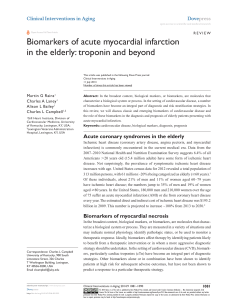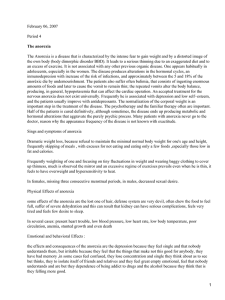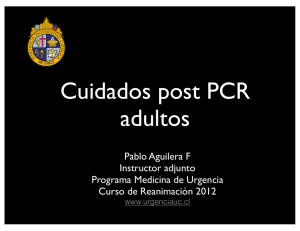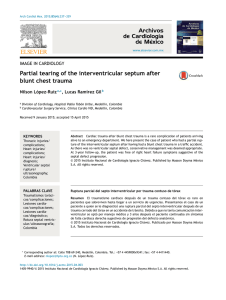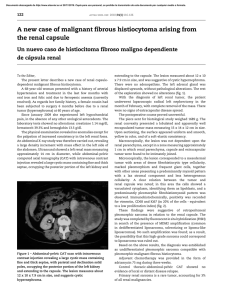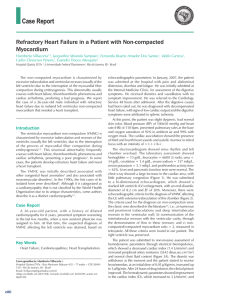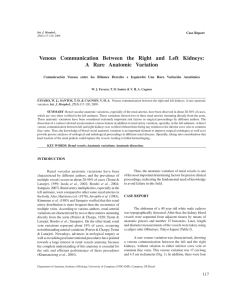behaviour and Prognostic Value of Serum cardiac troponin i in
Anuncio
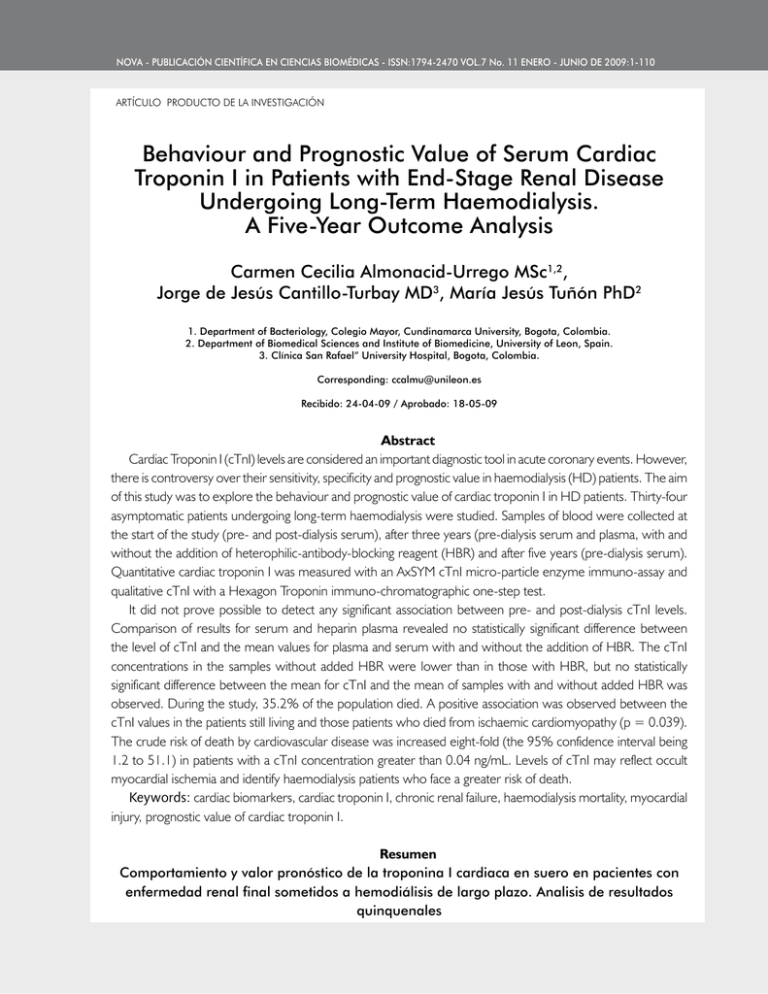
NOVA - Publicación Científica EN CIENCIAS BIOMÉDICAS - ISSN:1794-2470 Vol.7 No. 11 ENERO - JUNIO DE 2009:1-110 ARTÍCULO PRODUCTO DE LA INVESTIGACIÓN Behaviour and Prognostic Value of Serum Cardiac Troponin I in Patients with End-Stage Renal Disease Undergoing Long-Term Haemodialysis. A Five-Year Outcome Analysis Carmen Cecilia Almonacid-Urrego MSc1,2, Jorge de Jesús Cantillo-Turbay MD3, María Jesús Tuñón PhD2 1. Department of Bacteriology, Colegio Mayor, Cundinamarca University, Bogota, Colombia. 2. Department of Biomedical Sciences and Institute of Biomedicine, University of Leon, Spain. 3. Clínica San Rafael” University Hospital, Bogota, Colombia. Corresponding: ccalmu@unileon.es Recibido: 24-04-09 / Aprobado: 18-05-09 Abstract Cardiac Troponin I (cTnI) levels are considered an important diagnostic tool in acute coronary events. However, there is controversy over their sensitivity, specificity and prognostic value in haemodialysis (HD) patients. The aim of this study was to explore the behaviour and prognostic value of cardiac troponin I in HD patients. Thirty-four asymptomatic patients undergoing long-term haemodialysis were studied. Samples of blood were collected at the start of the study (pre- and post-dialysis serum), after three years (pre-dialysis serum and plasma, with and without the addition of heterophilic-antibody-blocking reagent (HBR) and after five years (pre-dialysis serum). Quantitative cardiac troponin I was measured with an AxSYM cTnI micro-particle enzyme immuno-assay and qualitative cTnI with a Hexagon Troponin immuno-chromatographic one-step test. It did not prove possible to detect any significant association between pre- and post-dialysis cTnI levels. Comparison of results for serum and heparin plasma revealed no statistically significant difference between the level of cTnI and the mean values for plasma and serum with and without the addition of HBR. The cTnI concentrations in the samples without added HBR were lower than in those with HBR, but no statistically significant difference between the mean for cTnI and the mean of samples with and without added HBR was observed. During the study, 35.2% of the population died. A positive association was observed between the cTnI values in the patients still living and those patients who died from ischaemic cardiomyopathy (p = 0.039). The crude risk of death by cardiovascular disease was increased eight-fold (the 95% confidence interval being 1.2 to 51.1) in patients with a cTnI concentration greater than 0.04 ng/mL. Levels of cTnI may reflect occult myocardial ischemia and identify haemodialysis patients who face a greater risk of death. Keywords: cardiac biomarkers, cardiac troponin I, chronic renal failure, haemodialysis mortality, myocardial injury, prognostic value of cardiac troponin I. Resumen Comportamiento y valor pronóstico de la troponina I cardiaca en suero en pacientes con enfermedad renal final sometidos a hemodiálisis de largo plazo. Analisis de resultados quinquenales 34 Behaviour and Prognostic Value of Serum Cardiac Troponin I in Patients with End-Stage Renal Disease Undergoing Long-Term Haemodialysis. A Five-Year Outcome Analysis. PÁGS. 34 - 42 / 124 Los niveles troponina I cardiaca (cTnI) se consideran una importante herramienta de diagnóstico en los eventos coronarios agudos. Sin embargo, hay controversia sobre su sensibilidad, especificidad y valor pronóstico en la hemodiálisis (HD) de los pacientes. El objetivo de este estudio fue explorar el comportamiento y el valor pronóstico de la troponina I cardiaca en pacientes en HD. Se estudiaron treintaicuatro pacientes asintomáticos sometidos a hemodiálisis a largo plazo. Las muestras de sangre fueron tomadas al inicio del estudio (pre-y post-diálisis en suero), después de tres años (pre-diálisis en suero y plasma, con y sin la adición de anticuerpos heterófilos reactivos de bloqueo (HBR) y después de cinco años (suero pre-diálisis). Se midió la troponina I cardiaca cuantitativa con micro-partículas AxSYM cTnI de la enzima inmuno-ensayo de cTnI y la cualitativa con una prueba de un solo paso de inmuno Troponina Hexagon-cromatografía. No fue posible detectar ninguna asociación significativa entre los niveles de cTnI pre-y post-diálisis. La comparación de los resultados de la heparina de suero y plasma no reveló ninguna diferencia estadísticamente significativa entre el nivel de cTnI y los valores promedio para el plasma y suero con y sin la adición de HBR. Las concentraciones cTnI en las muestras sin HBR añadido fueron más bajas que en aquellas con HBR, pero no se observó diferencia estadísticamente significativa entre la media de cTnI y la media de las muestras con y sin adición de HBR. Durante el estudio, el 35,2% de la población murió. Se observó una asociación positiva entre los valores de cTnI en los pacientes que aún viven y en los pacientes que murieron a causa de la miocardiopatía isquémica (p = 0,039). El crudo riesgo de muerte por enfermedad cardiovascular se ha multiplicado por ocho (el intervalo de 95% de confianza estando entre 1,2 y 51,1) en pacientes con una concentración de cTnI superior a 0,04 ng/ml. Los niveles de cTnI pueden reflejar la isquemia miocárdica oculta e identificar los pacientes en hemodiálisis que se enfrentan a un mayor riesgo de muerte. Palabras clave: biomarcadores cardíacos, insuficiencia renal crónica, lesión miocárdica, troponina I cardiaca, mortalidad de hemodiálisis, valor pronóstico de la troponina I cardiaca Introduction Cardiac disease is the leading cause of morbidity and mortality in patients with end-stage renal disease (ESRD). The prevalence of ischaemic heart disease (IHD) in haemodialysis patients is 10 to 20 times greater than in the general population, 50% of their mortality being due to cardiovascular disease (1). Patients with chronic renal failure (CRF) are at greater risk of silent ischaemia and atypical clinical presentation during an acute coronary syndrome. Angina is often absent in patients who suffer from both ESRD and coronary artery disease, occurring in only 17% of cases (2). Earlier detection of cardiovascular abnormalities in these patients might allow earlier interventions to reduce morbidity and mortality. However, in patients receiving maintenance dialysis, the clinical symptoms of cardiac damage are difficult to diagnose and may be misleading. In addition, the traditional cardiac markers, such as creatine kinase (CK), creatine kinase muscle-brain fraction (CK- MB) and myoglobin, have been found to be deceptively high in patients using dialysis (1-3). For this reason, some recent research has monitored cardiac biomarkers such as cardiac troponins and braintype natriuretic peptides (BNPs), in addition to clinical information such as diabetes and hypertension. The purpose was to assist in identifying ESRD patients with coronary artery disease who face a high risk of death (1,4). Furthermore, inflammation is known to play an essential role in the pathogenesis of coronary heart disease. Several studies have demonstrated that increased markers of inflammatory activity, like C-reactive protein (hs-CRP), pentraxin 3, pro-inflammatory cytokines and 8-oxo-7,8dihydro-2'deoxyguanosine, are associated with increased risk of death in healthy individuals, in patients with acute coronary syndrome, and in patients with impaired renal function (5,6). Some of these new biomarkers, such as the BNPs and hs-CRP, have been shown to be prognostic indicators of survival in patients with congestive heart 35 NOVA - Publicación Científica EN CIENCIAS BIOMÉDICAS - ISSN:1794-2470 Vol.7 No. 11 ENERO - JUNIO DE 2009:1-110 failure (4). However, there is controversy in the literature regarding the sensitivity, specificity and prognostic value of troponins, particularly cardiac troponin I (cTnI). Nonspecific raised cTnI has been reported in kidney patients in the absence of any clinical suspicion of acute myocardial ischaemia, possibly due to variable expression in extracardiac tissue as a consequence of the uraemic environment or to analytical interference from many nonspecific causes affecting almost all cTnI immunoassays, producing false positive or negative results (6,7). Furthermore, although recent studies demonstrate that serum or plasma cTnI is an important predictor of longterm, all-cause mortality and cardiovascular mortality in patients with ESRD, and that high concentrations of cTnI are associated with increased risk of coronary artery disease in this population (1-3), other studies conclude that cTnI has little predictive value in renal insufficiency and they do not identify it as an independent risk factor (8,9). Owing to the uncertainty about the usefulness of cTnI in ESRD, the aim of present study was to evaluate the behaviour and prognostic value of cTnI in a population of chronic haemodialysis patients. Subjects and Methods Subjects A total of 34 patients with end-stage renal failure undergoing long-term haemodialysis three times per week in the haemodialysis unit of the “Clínica San Rafael” University Hospital in Bogota, Colombia, were studied during the period 1999 to 2004. The patients had no history of angina during the previous three months or acute myocardial infarction (AMI) during the previous year. Exclusion criteria were: recent acute coronary artery disease (CAD) defined as occurring in the preceding three-month period, chest pain, major cardiovascular surgery, habitual consumption of cocaine, presence of rheumatoid factor, therapy with tricyclic antidepressives, and high concentrations of alkaline phosphatase. The study protocol was approved by the institutional committee for medical ethics of the “Clínica San Rafael” University Hospital and a written declaration of informed consent was obtained from each patient enrolled. The initial clinical evaluation included a review of medical 36 records and hospital information systems. Cardiac status was determined by two-dimensional echocardiography. The echocardiography was repeated again at the three-year point and a further clinical evaluation was undertaken after three and five years. All patients were treated with conventional bicarbonate haemodialysis using cellulose membranes. The duration of each dialysis session was four hours. Blood Sampling and Analysis Blood was collected from the patients during the second dialysis session of the week. At the beginning of the study, 10 mL of blood was collected before and after dialysis and centrifuged within one hour of collection. The serum samples were stored at -20oC until analysis. The concentrations for cTnI were obtained by means of a quantitative method. Three years later, a sample of serum and of heparin plasma was taken in the pre-dialysis session. The blood samples were centrifuged within 1 hour of collection and stored at -20oC until analysis. Measurement of cTnI was carried out with and without added heterophilic-antibodyblocking reagent (HBR), by means of a quantitative method. Five years after the study was initiated, predialysis serum samples were collected and cTnI was measured with a troponin I rapid bedside assay. Quantitative cTnI was measured with an AxSYM cTnI microparticle enzyme immuno-assay (Abbott Laboratories, Colombia). According to the manufacturer, cTnI concentrations of 0.04 ng/mL or greater were considered high. Qualitative cTnI values were obtained with a Hexagon Troponin immuno-chromatographic one-step test (Human Gesellschaft, Germany), with a sensitivity limit of about 1 ng/mL. The results were reported as positive or negative. Statistical Methods The level of cTnI was evaluated in continuous and categorical form for values equal to or less than 0.04. The following variables were categorized in binary (yes or no) form for analysis: aetiology of ESRD, associated pathology, initial heart disease, new cases of heart disease after three years. The respective categories are shown in Table 1. The final state of patients was categorized as: Behaviour and Prognostic Value of Serum Cardiac Troponin I in Patients with End-Stage Renal Disease Undergoing Long-Term Haemodialysis. A Five-Year Outcome Analysis. PÁGS. 34 - 42 / 124 still living, died of cardiovascular disease, and died from other causes. Analysis of the data was performed with the SPSS software package (version 13.0). The normality pair assumption was verified for quantitative variables (Shapiro-Wilk test). A non-parametric test (Wilcoxon) was used to compare cTnI levels. A Spearman’s rank correlation was carried out to evaluate the behaviour of cTnI with respect to age. The difference of proportions was obtained with chi-square test. Statistical significance was assumed for values of p less than 0.05. Two-by-two frequency tables were drawn up to obtain the ratio of disparity with a confidence interval of 95%. The values of cTnI in accordance with changes in heart disease were evaluated with the Friedman test. Results Patients Clinical characteristics and demographic information available for the 34 patients are summarized in Table 1. The average age of the population was 50 years, 60% of the patients were women, and the average number of months on dialysis was 23. With respect to the aetiology of chronic renal disease, the pathologies that predominated were hypertensive kidney disease and Type 2 diabetes mellitus. Hypertensive kidney disease was roughly equally spread between men and women, whereas Type 2 diabetes was twice as common in women as in men. The initial echographic evaluation confirmed that 35.3% of the patients had heart disease. The main cardiac pathologies Table 1. Clinical characteristics of the population studied 37 NOVA - Publicación Científica EN CIENCIAS BIOMÉDICAS - ISSN:1794-2470 Vol.7 No. 11 ENERO - JUNIO DE 2009:1-110 were cardiopathies. The second echocardiography showed 13 new cases of cardiac disease. In this case also, the largest percentage related to cardiopathies. Outcomes for Cardiac Troponin I The cTnI values for the whole population studied are given in Table 2. The amounts of cTnI recorded did not have a normal distribution in any of the measurements. The mean pre-dialysis concentration of cTnI was 0.46 ng/ mL, values ranging between 0.0 and 9.8, and the postdialysis average was 0.72 ng/mL, with a range of 0.0 to 13.3. No significant difference could be detected between the median values for the pre- and post-dialysis sessions (p = 0.213) at the beginning of the study, Table 2. Table 2. cTnI values for the population studied. 38 Behaviour and Prognostic Value of Serum Cardiac Troponin I in Patients with End-Stage Renal Disease Undergoing Long-Term Haemodialysis. A Five-Year Outcome Analysis. PÁGS. 34 - 42 / 124 Those patients for whom figures are not given died before the respective measurements were taken. Comparison of results for serum and heparin plasma revealed no statistically significant difference between the level of cTnI and the mean values for plasma and serum with and without added HBR (p = 0.480 and p = 0.063, respectively). Similarly there was no statistically significant difference between the first and the second quantitative measurements (p = 0.959 and p = 1.000, respectively). None of the patients had cTnI concentrations above the detection limit in the troponin I rapid bedside assay. There was no significant correlation between cTnI levels and age (p = 0.75) or between cTnI levels and the aetiology of chronic renal disease (p = 0.50). However, a statistically significant difference was found between cTnI values and sex (p = 0.00), cTnI concentrations and the associated pathology (p = 0.09), and between shorter times on dialysis and undetectable concentrations of cTnI (p = 0.027). Of the patients who had spent 1 to 23 months on dialysis, 70% had undetectable cTnI concentrations. In contrast, 76.5% of the patients who had 24 months or more of treatment showed cTnI levels greater than 0.04 ng/mL. With respect to the echographic evaluations, a borderline association was found between pre-dialysis cTnI levels and initial cardiac disease (p = 0.052), but not between post-dialysis levels and initial cardiac disease (p = 0.75). A significant association was observed between echographic changes corresponding to new cardiac damage and pre-dialysis cTnI concentrations in serum samples taken three years into the study (p = 0.00). During the five years of the study twelve false negative results were recorded, affecting nine patients at the beginning of the work and three patients at the three-year point. One false positive measurement of cardiac troponin I was also detected. Predictive Value of cTnI Measurements The clinical characteristics and cTnI levels for those patients who died are shown in Table 3. During the study 35.2% of the population died. Nine patients died during the first twelve months of observation and three over the course of the following four years. All the patients who died had cardiac disease, and in 58.3% of them, the cause of death was heart failure. Of the patients who died 75% had cTnI concentrations above the upper reference limit of 0.04 ng/mL. There was a statistically significant difference between pre-dialysis and post-dialysis cTnI and death from cardiac disease (p = 0.04 and p = 0.048, respectively), on which see Figure 1, and between cTnI levels and cardiac pathology in the patients who died (p = 0.038). The risk of death from cardiovascular disease was eight times higher for patients with a cTnI concentration greater than 0.04 ng/mL, as compared to those with an undetectable concentration (the 95% confidence interval being 1.25 to 51.3; p = 0.017). Consideration of cTnI levels and the vital state of the patients demonstrated a significant association between survival and cTnI concentrations of 0.0 ng/mL (p = 0.037). Of the 22 patients who survived the three phases of the study, 72% had undetectable concentrations of cTnI in all their evaluations and were still alive in the first quarter of 2007, Figure 1, Table 3. Discussion Troponin I is a highly sensitive and specific marker for myocardial ischaemia. This specificity has engendered a great deal of interest in its value as a marker of subclinical ischaemia and as a predictor of death among haemodialysis patients. However, the existence of different cTnI assays with a wide diversity of cut-off values, the variability in pre- and post-dialysis determinations and the presence of false positive and negative results combine to create confusion and limit the implementation of cTnI as a screening test for ESRD patients. The findings presented here confirm other studies in several aspects related Figure 1. Pre-dialysis cTnI and death from cardiovascular disease. 39 NOVA - Publicación Científica EN CIENCIAS BIOMÉDICAS - ISSN:1794-2470 Vol.7 No. 11 ENERO - JUNIO DE 2009:1-110 Table 3. Clinical characteristics and cTnI levels for patients who died. to the specificity, prognostic value and methods for quantification of cTnI, and add new data that contribute to evaluation of a potential role for this biomarker to aid in clinical decisions concerning ESRD patients. Few studies have compared cTnI concentrations before and after dialysis sessions, and their results are contradictory. Some of them have shown greater cTnI levels after dialysis, others before, yet others have not detected significant changes between pre- and post-dialysis values (3,9-11). Reasons for this variation might include the type of clearance and the membranes used in the dialysis. With high-flux membranes, diffusive clearance removes molecules up to 15 kDa, whereas with low-flux membranes, only molecules up to 5 kDa are removed. Convective clearance removes molecules up to a high molecular mass when high-flux membranes are used, but only molecules up to 9 kDa with low-flux membranes (10). This hypothesis 40 is sustained by several studies that report increases and decreases in post-dialysis levels of cTnI, with the same type of membrane used (3). Other possible causes are the absorption of TnI isoforms by the dialysis membrane and the type of methodology employed for measuring cTnI (9,11). A recent study compared pre- and post-dialysis cTnI concentrations, second and third generation immuno-assays being used. Eleven patients had higher pre-dialysis cTnI levels with the second immuno-assays, and only one with the third generation (11). The findings reported here showed no changes between pre- and post-dialysis evaluations using a low-flux membrane (cellulose) and a second generation immuno-assay. Owing to the variations in the levels of cTnI, the authors of this paper concur with other workers in the field in recommending pre-dialysis estimations. Behaviour and Prognostic Value of Serum Cardiac Troponin I in Patients with End-Stage Renal Disease Undergoing Long-Term Haemodialysis. A Five-Year Outcome Analysis. PÁGS. 34 - 42 / 124 Although for the last decade cTnI has been considered the most specific among the currently available biochemical markers of myocardial damage, its value in the presence of chronic kidney failure has been questioned, mainly because of the presence of nonspecific rises in patients, whether or not they are being treated with renal substitution (7,8-12). The cause of these is not clear. The current hypotheses include micro-injuries to the myocardium that remain undetected by conventional cardiac imaging, cardiotoxicity due to changes in osmolarity and/or ion fluxes, increased cardiac preload and myocardial stretch due to volume overload and non-ischaemic cardiac injury due to calcium and oxalate deposition in the heart (8). Other reasons for raised cTnI are the analytical interferences that affect almost all cTnI immuno-assays. The most frequently described interfering mechanisms are those caused by heterophilic antibodies, human antimouse antibodies, rheumatoid factor, macromolecular complex, circulating cTnI auto-antibodies and incomplete serum separation (7,12). One of the strategies used to diminish these interferences is the addition of heterophilicantibody-blocking reagent (HBR). This method has been used successfully in populations other than those of patients with kidney failure, but not in haemodialysis patients (12). The findings reported here also show the presence of false positive and negative results and do not demonstrate statistically significant differences between the samples with and without added HBR or between plasma and serum. This probably means that the nonspecific results found are not the consequence of a high titre of heterophilic antibodies but rather of some other type of interference, or that the blocking reagent HBR does not work on this population of patients. However, in accordance with the views of other authors, they do allow the recommendation of plasma as the sample of choice for cTnI quantification in haemodialysis patients. The American College of Cardiology (ACC)/American Heart Association (AHA) guidelines recommend that laboratories should provide cardiac biomarker results within 30 to 60 minutes, and the US National Academy of Clinical Biochemistry recommends bedside or pointof care testing if laboratories cannot provide cardiac biomarker results consistently within one hour (13). For this reason, rapid bedside cTnI assays have been successfully trialled on patients with acute coronary syndrome, but they have not been extended to those with ESRD. The only study so far published concludes that the fast tests are less specific than quantitative tests for the detection of acute and chronic cardiac manifestations in patients with terminal renal failure (14). The results of the work being reported here agree with that study, since whether or not they had a documented cardiac pathology, none of the patients showed positive with the Hexagon Troponin test. However, in a parallel study it was observed that the same method was specific for the diagnosis of acute myocardial infarction and unstable angina. On this basis, it is possible to suggest that the Hexagon Troponin test is suitable for acute myocardial injury, but its use is limited in chronic cardiac pathologies like uraemic cardiomyopathy. Nevertheless, further research with a larger number of patients would be advisable, so as to confirm these findings. Although over the last 10 years increases in cTnI have been observed in ESRD patients (8,15-17), the controversy surrounding their specificity and the association between troponin I and mortality from all causes is not unfounded, and the available evidence does not clarify this association. The present study offers various pieces of data that may contribute in elucidating this situation. First, raised cTnI, as defined by the reference limit for normal subjects, was associated with an eight-fold greater risk of death. These findings are consistent with previous studies that associate high concentrations of cTnI with a greater risk of mortality and suggest that the relative risk of death varies in accordance with the cut-off point used in each study (1-3,15,18). Second, the difference in cTnI levels between patients having spent longer and shorter times on dialysis permits consideration of the possibility that haemodialysis itself could induce myocardial ischaemia and a minor degree of troponin I release in patients undergoing haemodialysis treatment. This hypothesis is also supported by other investigators (18). With respect to the specificity of cTnI, some studies demonstrate that cTnI is highly specific in this type of patients (1,2,18,19) whereas others do not acknowledge this (8,9,17). In the current research, a significant association was demonstrated between cTnI 41 NOVA - Publicación Científica EN CIENCIAS BIOMÉDICAS - ISSN:1794-2470 Vol.7 No. 11 ENERO - JUNIO DE 2009:1-110 concentrations and the presence or absence of cardiac disease. These data suggest that cTnI levels can serve as a useful marker of myocardial injury in patients with ESRD on haemodialysis. However, the limited number of patients did not allow measurement of the specificity and sensitivity of this test. Finally, although a few studies exist that evaluate short- and long-term survival in haemodialysis patients (8,9,20), the percentage of survivors in the present study points to the possibility of using undetectable cTnI concentrations as a predictor of survival in this population. In conclusion, the findings suggest that increases in circulating cTnI in stable asymptomatic haemodialysis patients are associated with a greater risk of death. Nevertheless, precision always must be considered within a suitable clinical context, and the variables derived from the quantification method used require proper evaluation. Acknowledgements We should like to express our thanks to Abbott Laboratories of Colombia and Human Gesellschaft für Biochemica und Diagnostica m.b.H. of Germany for providing the reagents used in this study. Conflict of interest statement: No conflict of interest is declared. References 1. Vichairuangthum K, Leowattana W, Ong-Ajyooth L, Pokum S. The relationship between serum concentration of cardiac troponin I in chronic renal failure patients and cardiovascular events. J Med Assoc Thai. 2006;89:714-719. 2. Bueti J, Krahn J, Karpinski M, Bohm C, Fine A, Rigatto C. Manitoba Renal Research Group. Troponin I testing in dialysis patients presenting to the emergency room: does troponin I predict the 30-day outcome?. Nephron Clin Pract. 2006;103:129-136. 3. Farkouh M, Robbins M, Zafar U, Shimbo D, Davidson K, Puttappa R. Association between troponin I levels and mortality in stable hemodialysis patients. Am J Med. 2003;114:224-226. 4. Mácsai E, Széll J, Ladányi E, Treszl A, Vásárhelyi B, Madácsy L. Determining factors of cardiac biomarkers in hemodialysed diabetic and non-diabetic patients. Orv Hetil. 2007;18:483-488. 42 5. Tripepi G, Mallamaci F, Zoccali C. Inflammation markers, adhesion molecules and all-cause and cardiovascular mortality in patients with ESRD: searching for the best risk marker by multivariate modeling. J Am Soc Nephrol. 2005;16:S83-88. 6. Huseyin B, Aylin Y, Haldun M. Cardiac enzymes, renal failure and renal transplantation. Clin Med & Research. 2006;4:79-84. 7. Eriksson S, Halenius H, Pulkki K, Hellman J, Pettersson K. Negative interference in cardiac troponin I immunoassays by circulating troponin autoantibodies. Clin Chem. 2005;51:839-847. 8. Khan IA, Wattanasuwan N, Mehta NJ, Tun A, Singh N, Singh HK, Vasavada B, Sacchi T. Prognostic value of serum cardiac troponin I in ambulatory patients with chronic renal failure undergoing longterm hemodialysis. A two-year autcome analysis. J Am Coll Cardiol. 2001;38: 991-998. 9. Peetz D, Schütt S, Sucké B, Faldum A, Wandel E, Hafner G, Lackner K. Prognostic value of troponin T, troponin I, and CK-MBmass in patients with chronic renal failure. Med Klin. 2003;98: 188-192. 10. Wayand D, Baum H, Schätzle G, Schärf J, Neumeier D. Cardiac Troponin T and I in end-stage renal failure. Clin Chem. 2000;46:1345-1350. 11. Deleaval P, Descombes E, Magnin JL, Martin PY, Fellay G. Diferences in cardiac troponin I and T levels measured in asymptomatic hemodialysis patients with last generation immunoassays. Nephrol Ther. 2006;2:75-81. 12. Kim W, Laterza O, Hock K, Pierson-Perry J, Kaminski D. Performance of a revised cardiac troponin method that minimizes interferences from heterophilic antibodies. Clin Chem. 2002;48: 1028-1034. 13. Saadeddin S, Habbab M, Siddieg H, Fayomi M, Dafterda R. Reliability of the rapid bedside whole-blood quantitative cardiac troponin T assay in the diagnosis of myocardial injury in patients with acute coronary syndrome. Med Sci Monti. 2004;10:43-46. 14. Lang K, Schindler S, Forberger C, Stein G, Figulla HR. Cardiac troponins have no prognostic value for acute and chronic cardiac events in asymptomatic patients with end-stage renal failure. Clin Nephrol. 2001;56:44-51. 15. Boulier A, Jaussent I, Terrier N, Maurice F, Rivory J-P, Chalabi L, Boularan1 AM, Delcourt C, Dupuy AM, Canaud B, Cristol JP. Measurement of circulating troponin Ic enhances the prognostic value of C-reactive protein in haemodialysis patients. Nephrol Dial Transplant. 2004;19:2313-2318. 16. Huseyin B, Aylin Y, Haldun M. Cardiac enzymes, renal failure and renal transplantation. Clin Med & Research. 2006;4:79-84. 17. Khan N, Hemmelgarn B, Tonelli, M, Thompson C, Levin A. Prognostic value of troponin T and I among asymptomatic patients with end-stage renal disease. A meta-analysis. Circulation. 2005; 112:3088-3096. 18. Beciani M, Tedesco A, Azzarito M, Violante A. Cardiac troponin in chronic hemodialysis. Comparasion of methods and results after 3 months. Recenti Prog Med. 2001;92:660-662. 19. Apple F, Murakami M, Pearce L, Herzog C. Predictive value of cardiac troponin I and T for subsequent death in end-stage renal disease. Circulation. 2002;106:2941-2945. 20. Urso S, Garozzo M, Milone F, Battaglia G. Cardiovascular risk markers in hemodialysis patients. Int J Artif Organs. 2004;27:1083-1090.

